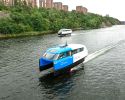On Predictive Maintenance for Maritime Sector Using AI-Based Analysis of Partial Discharge
Contact: Lucas Finati Thomée, DNV
This report presents a pre-study on applying Partial Discharge (PD) and anomaly analyses for predicting failures in maritime electrical power systems. The maritime environment’s elevated humidity, saltwater exposure, and mechanical stresses make electrical systems aboard vessels especially prone to insulation breakdown, which can lead to propulsion, distribution, and communications failures. In this context, PD—a localized dielectric breakdown—serves as a crucial early warning indicator of insulation deterioration.
Using test objects with simulated defects representative of maritime components, this study compiled 345,660 PD events that were categorized into 10 distinct types. Through advanced feature engineering, key attributes such as maximum PD amplitude, duration, inter-PD intervals, and the area under the PD curve were extracted and analyzed. Two machine learning architectures—an ensemble bagged Decision Tree and a Long Short-Term Memory network—achieved classification accuracies of 95.3% and 98.5%, respectively. These results indicate that PD-based predictive maintenance with machine learning can offer precise fault diagnosis and early warning before more severe electrical failures occur.
The findings show a robust predictive capability that links specific PD signatures to emerging electrical insulation faults. This high predictive accuracy not only reduces uncertainty in diagnosing potential electrical failures but also confers notable benefits regarding operational efficiency, safety, and sustainability. Early PD detection makes it possible to schedule proactive and timely repairs, thereby reduce unexpected downtime, minimize operational costs and repair expenses, and ensure the uninterrupted operation of essential activities. Furthermore, it decreases the likelihood of high-impact incidents at sea that can burden shipping companies with extensive direct and indirect costs, enhances safety for passengers and crew, and it also promotes sustainability by possibly preventing environmental hazards associated with the potential incidents. This approach also optimizes electrical system performance, leading to energy savings by avoiding inefficient operations caused by deteriorating components.
-
 Ny studie: Eldrivna pendelbåtar kan effektivisera Stockholms kollektivtrafik
Ny studie: Eldrivna pendelbåtar kan effektivisera Stockholms kollektivtrafik -
 EU: Sjöfartens utsläpp ökar
EU: Sjöfartens utsläpp ökar -
 Sociala relationer påverkar val av bränsle
Sociala relationer påverkar val av bränsle -
 Sjöfartens omställning kräver ”mjukare” påtryckningar
Sjöfartens omställning kräver ”mjukare” påtryckningar -
 Hon hade avtalad tid med Kapten ynkrygg
Hon hade avtalad tid med Kapten ynkrygg -
 Lighthouse omvärldsanalys 2025 – osäkerhet och tullar präglar sjöfarten
Lighthouse omvärldsanalys 2025 – osäkerhet och tullar präglar sjöfarten -
 Se seminariet Shipping in the Marine Environment
Se seminariet Shipping in the Marine Environment -
 Vad betyder egentligen de 90 procenten?
Vad betyder egentligen de 90 procenten? -
 Hålla där...
Hålla där... -
 Ny rapport: Klimatförändringarna ett hot mot de flesta större hamnar i världen
Ny rapport: Klimatförändringarna ett hot mot de flesta större hamnar i världen

